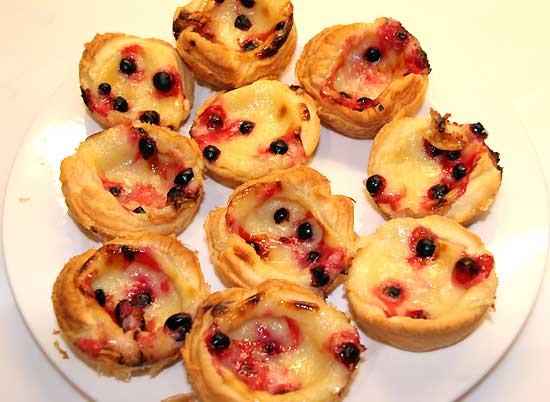|
Redcurrant Portuguese Custard Tarts |
Printer Friendly Copy |
 |
|
| Makes 12 |
Prep 10 mins |
Cooking 30 mins |
Challenge |
|
| |
|
|
My rating |
 |
Ingredients |
For the pastry cases
15g melted butter or oil for greasing
2 tbsp plain flour, for dusting
320g pre-rolled all-butter puff pastry
|
For the sugar syrup
1 orange
200g granulated or caster sugar
100g water
1 star anise
1 cinnamon stick
|
For the custard
2 tbsp corn flour
250ml whole milk
4 large egg yolks
1 tsp vanilla paste
A handful of redcurrants
|
|
-
Preheat the oven to
200C/400F/gas mark 6. Brush the inside of a 12-hole
cupcake tin with a little butter or oil, then dust with
flour and shake off the excess.
-
Using a 10cm-round cookie
cutter, cut out discs of pastry and push down into the
holes. They will not come up to the full height of the
tins. You should get about 8 discs from the first sheet of
pastry. Stack the off cuts on top of each other (rather
than just squishing together, which would destroy the
layers of butter), roll out to 3mm thick and cut out the
remaining 4 rings. Place the pastry tin in a freezer for
10 minutes.
-
Meanwhile, make the sugar
syrup. Use a potato peeler to cut strips of zest from the
orange. Place in a small saucepan with the sugar, water,
star anise and cinnamon stick. Heat gently at first until
all the sugar is dissolved, then turn the heat up and boil
the syrup until it reaches 105 C on a sugar thermometer.
Once cooled, discard the cinnamon stick, anise and orange
peel.
-
Mix together the corn flour
with a little milk to form a smooth paste. Stir this paste
gradually into the remaining milk, beaten egg yolks and
vanilla paste. Cook in a saucepan on a low/medium heat for
about 8 minutes until the custard has thickened. Add the
sugar syrup and allow to cool at room temperature.
-
Pour the custard into the
pastry cases, aiming to fill to a few millimetres below
the rim. Sprinkle 4 or 5 redcurrants in each, then place
in the oven for 16-20 minutes. They are ready when the
custard is billowing up and dark brown spots of
caramelisation appear on the surface.
|
|
 DAILY
DINNERS
DAILY
DINNERS  DAILY
DINNERS
DAILY
DINNERS